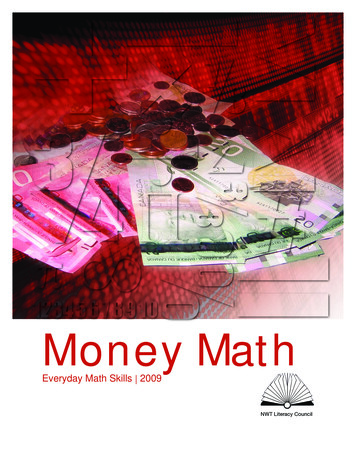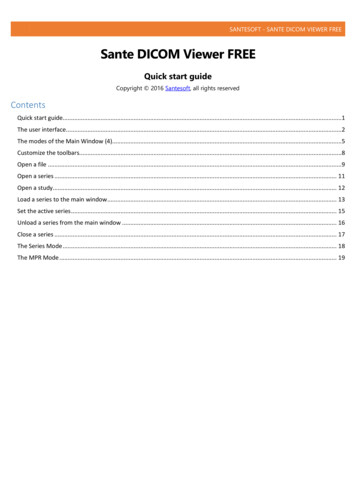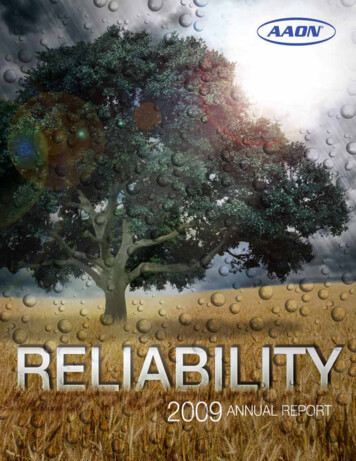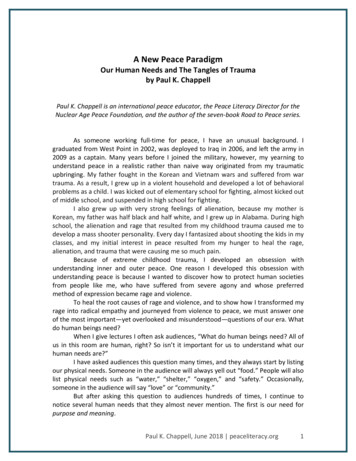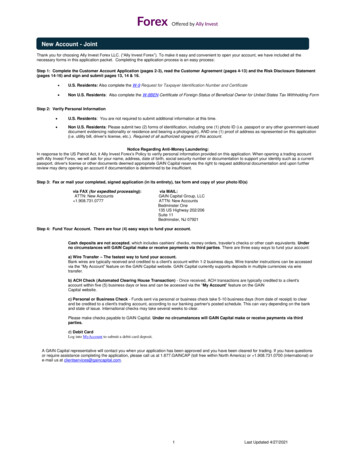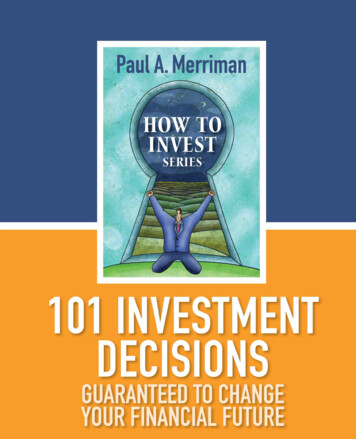
Transcription
“How To Invest” series101 Investment DecisionsGuaranteed to ChangeYour Financial FuturePaul A. Merrimanwith Richard BuckREGALOeducate – empower
II101 Investment Decisions Guaranteed to Change Your Financial FuturePublished by Regalo LLCCopyright 2012 Paul Merriman and Richard Buck.All rights reserved. Except as permitted under the United States Copyright Act of 1976, no partof this publication may be reproduced, or distributed in any form or by any means, or storedin a database or retrieval system without prior written permission of the publisher, except bya reviewer who may quote brief passages in a review.ISBN-13: 978-1479315963ISBN-10: 1479315966This publication is designed to provide accurate and authoritative information in regard to thesubject matter covered. It is sold and otherwise distributed with the understanding that neitherthe authors nor publisher is engaged in rendering legal, accounting, securities trading or otherprofessional services. If legal advice or other expert assistance is required, the services of acompetent professional person should be sought. – From a Declaration of Principles JointlyAdapted by a Committee of the American Bar Association and a Committee of Publishersand AssociationsTo contact Regalo LLC, please email us at info@paulmerriman.comAll profits from the sale of this book – and all books in the “How ToInvest” series – are donated to educational non-profit organizations. Formore information, visit http://www.www.PaulMerriman.comEditorial & Marketing: Aysha GriffinCover Design: Anne Clark Graphic DesignFormatting: VirtualMargie.com
101 Investment Decisions Guaranteed to Change Your Financial FutureIIIAcknowledgementsThis workbook is written to help the full range of investors – from first-time investorsto those planning for early retirement.This workbook is made up of my views on 101 decision points that can – and often do– add or subtract untold numbers of dollars to the investments we count on to keepus financially fit. Many of these choices can also have a profound effect on our peaceof mind.Some of the subject matter will be familiar from my books. However, many of thetopics in these questions are not covered in the books at all, and others get much moredetailed treatment here. By breaking this into specific decisions, I hope I’ve made iteasy for you to quickly find and focus on issues that matter to you, while you skip overothers that might not apply.If you have a question that isn’t addressed in this workbook, I’ll be happy to help youwith the answer. Feel free to email me at info@paulmerriman.com.I also invite you to visit my website for current mutual fund and ETF recommendations,podcasts, articles, events, and other information at paulmerriman.com.Please note that all profits from the sales of my books are donated to The MerrimanFinancial Educational Foundation, which is dedicated to providing comprehensivefinancial education to investors, with information and tools to make informeddecisions in their own best interest and successfully implement their retirementsavings program.Paul Merriman
IV101 Investment Decisions Guaranteed to Change Your Financial Future
101 Investment Decisions Guaranteed to Change Your Financial FutureVContents1101 Investment Decisions Guaranteed to Change Your Financial Future3Part 1: The Basics19Part 2: Equity Investing31Part 3: Fixed-Income Investing41Part 4: Asset Allocation and Risk Control45Part 5: Selecting Mutual Funds57Part 6: Selecting an Advisor69Part 7: Insurance75Part 8: Retirement Accounts and Planning for Retirement91Part 9: Forward into the Future93Appendix A: Asset Allocation99About the Authors103About the How To Invest series
VI101 Investment Decisions Guaranteed to Change Your Financial FutureIntroductionThis workbook is written to help a full range of investors, from first-time investors tothose planning for early retirement.The bulk of this workbook is made up of my views on 101 decision points that can –and often do – add or subtract untold numbers of dollars to the investments we counton to keep us financially fit. Many of these choices can also have a profound effect onour peace of mind.Some of the subject matter will be familiar from my books. However, many of thetopics in these questions are not covered in the books at all, and others get much moredetailed treatment here. By breaking this up into specific decisions, I hope that I havemade it easy for you to quickly find and focus on issues that matter to you, while youskip over others that might not apply.If you have a question that isn’t addressed in this workbook, I’ll be happy to help youwith the answer. Feel free to email me at pm@paulmerriman.com.I also invite you to visit and sign up at my website for current mutual fund and ETFrecommendations, podcasts and articles at paulmerriman.com.Please note that all profits from the sales of my books are donated to educational nonprofit organizations.Paul Merriman
101 Investment Decisions Guaranteed to Change Your Financial Future1101 Investment DecisionsGuaranteed to Change YourFinancial FutureEvery decision in this book is one you will make or have already made, whether youknow it or not. You can make these choices by default, not realizing you’re doing it. Oryou can make them by design, which is how I recommend you do it.I believe that every item here has the potential to add at least 1,000 to your wealth.Most can add 10 times that much, and some could add 100,000 or more. Together,they can add up to millions of extra dollars for you and your family over the years.The choices you make are guaranteed to change your future. The future is unknown,and I can’t guarantee the results you’ll get from these decisions. But the followingbrief discussions are all based on lots of history, and I believe that history indicates myrecommendations have a high probability of success.These decisions are designed to help you adopt the very best practices of investing, ineasy steps. I have tried to break each item down to the basic elements so it is easy todeal with.This book is not an essay for you to read and then put away. This is a workbook, andit’s only valuable to the extent that you put it to work for you. At the end of each itemare four boxes for you to check – or not. The first box will let you indicate whether ornot the item applies to you and calls for some sort of action. If you check that box, youshould also check one of the next three, indicating the priority you assign to it.“A” priority means you think that you should put this item near the top ofyour to-do list.“B” priority means you believe there’s strong potential benefit for you, butother things are more urgent or have greater immediate potential.“C” priority means this is not a task that calls for action right away, butit’s something you want to remember and revisit when you can.
2101 Investment Decisions Guaranteed to Change Your Financial Future
101 Investment Decisions Guaranteed to Change Your Financial Future3Part 1: The BasicsSome of these topics seem extremely basic. You may think they’re notworth your time. But remember, I believe that each one is potentiallyworth at least 1,000.1. If you have money beyond your immediateneeds, will you save it or spend it?Save vs. spend is the most basic investment decision you can make.But before you dismiss this as not worth your time, think aboutStarbucks for moment. I have spoken with dozens of young people asthey buy drinks at Starbucks or carry them back to where they work.Most of them tell me they are not maxing out their retirement plansbecause they don’t have enough money. Many say they make threeStarbucks runs a day, even though free coffee is available at theiroffices. Many also buy their lunches every day.A little math would tell them they’re spending an unnecessary 50 ormore every week. With a relatively simple change in their habits, theycould easily add 2,500 a year to their retirement plans. They wouldprobably be astonished to know what that savings could do for them.Invest 2,500 a year at 8 percent, and in 40 years you’d have nearly 650,000 (If you make the right choices in the other decision pointsin my list, you can probably boost your expected return to 10 percent.That would make the 650,000 worth more than 1 million).Although I don’t know you, I am pretty confident that you areregularly spending at least some money that you don’t need to spend.Can you change a few habits and beef up your savings?—This appliesto me.o Priority Ao Priority Bo Priority C
4101 Investment Decisions Guaranteed to Change Your Financial Future2. Should you save in tax-deferred accounts ortaxable ones?There are huge tax savings available from IRAs and employerretirement plans such as 401(k) and similar plans. If you put aside 5,000 a year for 40 years in a tax-deferred account, you could easilygain an annual return advantage of one percentage point and save 300,000 in taxes. And this doesn’t even include the extra moneyyou could invest every year from the tax deduction you’d get forcontributing to a 401(k) or a deductible IRA. That’s not all. Youremployer might match part of your 401(k) investment; if that were 1,500 a year, after 40 years at 8 percent, you’d have an additional 400,000 in your retirement account.3. Should you save in a Roth account (either 401(k)or IRA) or a traditional account?This choice is all about whether you pay taxes now or pay taxeslater. The conventional wisdom asks you to guess (which is the bestanybody can do) whether income tax rates that apply to you will behigher after you retire (in which case the Roth is the right choice)or lower after you retire (in which case the traditional is the betterchoice). Because we can’t know the future of tax laws, this is a toughchoice. But there are some things that we can and do know.We know that contributions made into Roth accounts are not taxdeductible. There’s no tax refund that you could spend or save.The effect is that you save more money by using a Roth IRA than atraditional IRA. By paying the tax now on contributions, you gain theadvantage of tax-free withdrawals after you retire.Personally I believe that income tax rates are likely to be far higherin the future; if I’m right, it makes sense to pay taxes at current ratesinstead of future ones. So I recommend using the Roth IRA or 401(k)if you qualify.—This appliesto me.o Priority Ao Priority Bo Priority C
101 Investment Decisions Guaranteed to Change Your Financial FutureRoth accounts have two other advantages. First, they are not subjectto Required Minimum Distributions starting when you’re age 70½.Second, you can leave a Roth account to your heirs, who can taketax- free distributions over their own lifetimes. I think this makes theRoth one of the greatest estate-planning tools available.5—This appliesto me.o Priority Ao Priority Bo Priority C4. Should you start serious investing now, or waituntil you have enough money?From my perspective, this is a no-brainer if there ever was one.Investment results depend on three things: your savings, the rate atwhich your money grows, and the amount of time your savings cangrow.Time is a huge factor in this equation, one that most peopleunderestimate. If you save 5,000 a year for 40 years and earn 8percent, you’ll eventually have nearly 1.3 million. But think aboutthis: Of that 1.3 million, about 434,000 comes from your first fiveyears of savings; that’s about one- third of your total, from only oneeighth of the dollars you saved. If you waited five years to start yoursavings plan (and thus the total was 35 years instead of 40), you’d endup with only about 862,000 instead of 1.3 million. At a withdrawalrate of 5 percent, 40 years of savings would give you a retirementincome of nearly 65,000, while 35 years of savings would cut thatfigure to 43,000.5. Should you save 5 percent of your income, or 10percent?When you’re young, setting aside 5 percent of your income for thedistant future may hurt, at least a little. Doubling that to 10 percentmay seem really painful, when there are so many other demandson your income, everything from establishing your family to payingoff student loans to acquiring housing. So this is a decision that,while it’s simple, probably isn’t easy. However, it’s easy to calculatethis mathematically. If this week you save 200 instead of 100,—This appliesto me.o Priority Ao Priority Bo Priority C
6101 Investment Decisions Guaranteed to Change Your Financial Futureeventually you’ll have twice as much money (at least from this week’scontribution) on which to retire.You might be surprised how much difference this makes over aninvesting lifetime. Assuming you are investing for 40 years at 8percent, we can trace the effect of that extra 100 you could save thisweek. If you saved only 100, you would have 2,172; if you saved 200, you’d have twice that much, 4,345. Those extra few thousanddollars won’t change your life.But think about what would happen if you saved that extra 100 for2,000 weeks over the years. The difference: 1.34 million vs. 2.68million. My recommendation is to establish the habit of saving 10percent of your income. Think of this as paying yourself first. It mayhurt now, but eventually you’ll be very glad you did it.6. Should you invest in stocks or invest in bonds?Actually, I think you should probably do both. When you invest in acompany’s stock (I don’t recommend you do this one company at atime, but thinking about a single company makes this comparisoneasier), you become an owner. As such, you assume the risks of all thethings that could happen to hurt that company, from bad managementto bad products to increased competition to huge liability lawsuits. Inreturn, you gain the right to share in whatever success the companymay experience. If things go well, you could make a lot of money; ifthings go poorly, you could lose most or all of your investment.When you buy that company’s bond, you are merely loaning thecompany money. As long as the company can repay the loan andmake the interest payments, you don’t have to worry about how thebusiness is doing. In exchange for that lack of angst, you agree toaccept a fixed rate of return that’s probably much lower than thepotential for stock investors.Over the long term, stocks have outperformed bonds in two of everythree years, and the difference is typically five to 10 percentage points—This appliesto me.o Priority Ao Priority Bo Priority C
101 Investment Decisions Guaranteed to Change Your Financial Future7a year. These numbers apply when you invest through mutual fundsthat own bonds by the hundreds and stocks by the hundreds orthousands.From 1927 through 2011, Treasury bills compounded at 3.6 percent ayear; in the same period, U.S. small-cap value stocks compounded at13.5 percent. On a 10,000 investment held for 30 years, that is thedifference between winding up with 28,893 and 446,556. Even asmall percentage of equities in a portfolio can have a major impact onwhat you have to live on in retirement.Those stocks, of course, were vastly more volatile than T-bills, andthat’s why stocks aren’t suitable for short-term investments.—This appliesto me.o Priority Ao Priority Bo Priority C7. Should you own one stock or many stocks?Here are two facts that seem like opposites, but both are true. Thehighest expected returns involve owning a single stock like Google,Microsoft or Apple. The lowest expected returns involve owning asingle stock like Enron or Washington Mutual. Owning just one stockchanges the process from investing to speculating. Most companiesfirst offer their stock to the public when they seem to have brightfutures full of promise. Only a few live up to that promise, and manywind up losing money or going out of business. Many people have losttheir entire investments when they bought one stock.By contrast, there’s never been a case in which a broadly diversifiedportfolio of stocks has lost everything. Every year I give a talk to highschool students. I ask them if they want to invest like millionaires.Without exception, they say they do. Then I point out that millionairesinvest in hundreds or thousands of companies, instead of only ina few. The good news is that if you have a few thousand dollars,you can invest like a millionaire through mutual funds. That’s myrecommendation.—This appliesto me.o Priority Ao Priority Bo Priority C
8101 Investment Decisions Guaranteed to Change Your Financial Future8. Should you buy stocks in one industry that youunderstand, or diversify across many industries,including those you don’t understand?I have a friend who’s been a successful banker his whole career, andmost of his money was invested in banking companies. After all, heknew that industry better than most people.His largest holding by far was the stock of Washington Mutual, avenerable Washington state institution that seemed a bedrock ofstability. But within about a decade, Washington Mutual morphedfrom being a local “friend of the family” (the company’s longtimemarketing slogan) to the country’s largest thrift institution, then tothe largest U.S. bank failure of all time.Despite his extensive knowledge of the industry, my friend didn’tsee this coming. As a result, he lost the majority of his retirementsavings. The upshot for him: The comfortable retirement he hadplanned will be much more modest, and it will be postponed untilhe’s at least 70. My friend’s unfortunate experience illustrates the factthat there’s no evidence that investing in a single industry providesa high probability of success. However, investing in many industrieshas provided a high historical probability of long-term success.9. Should you invest in one asset class or many?This is a variation of the choice to invest in many stocks andmany industries. An asset class is a group of stocks with commoncharacteristics. The best-known example is the Standard & Poor’s500 Index, which represents the 500 largest U.S. stocks, includingmany well-known companies like General Electric, Citibank andApple. This familiarity leads some investors to think that 500 stocksis enough diversification, and this asset class may represent most orall of their portfolios.However, investing isn’t quite that simple, and some asset classes,including the S&P 500 Index, can spend many years underperforming—This appliesto me.o Priority Ao Priority Bo Priority C
101 Investment Decisions Guaranteed to Change Your Financial Future9other asset classes. In my books and in this workbook, I recommenda number of asset classes, most of which have higher long-termcompound returns than the S&P 500 Index.In the 10 years ended in December 2010, the S&P 500 Index madeonly 1.4 percent a year, including reinvestment of dividends. In thosesame 10 years, a portfolio that included the S&P 500 Index and manyother asset classes grew at a compound rate of about 7.3 percent.—This appliesto me.o Priority Ao Priority Bo Priority CMy recommendation won’t surprise you: choose many instead of one.10. Should you invest in one country or manycountries?Many U.S. investors believe the companies headquartered in thiscountry give them everything they need. But I think they’re wrong.One of the most important forks in the road for investors is whetheror not to invest in international funds.For more than 15 years, I have recommended having half yourequity portfolio in international funds. In the late 1990s when theU.S. market was outperforming everything else, this was not apopular recommendation. But in the following decade, internationaldiversification was a great benefit. Over long periods of time, academicstudies have found again and again that adding international stocksreduces the risks of a portfolio, provides currency diversification andincreases annual returns by about one percentage point.11. Should you invest your whole portfolio in equityfunds or include fixed-income?To make sure you get this right, I suggest you consult Appendix A, B andH in my book “Financial Fitness Forever”. You will find AppendixA reprinted at the end of this workbook. If you are frugal, likemany of my readers, check with your local library to see if it’s available.Whether you buy the book or check it out from the library, I strongly—This appliesto me.o Priority Ao Priority Bo Priority C
10101 Investment Decisions Guaranteed to Change Your Financial Futuresuggest you read all 77 pages of the appendices as they contain some ofthe best statistical information I have used to make my own investmentdecisions and recommended to my clients when I was an advisor.Very young investors should have all their investments in equityfunds.Retirees, on the other hand, need stability in their portfolios morethan high growth potential. They typically should have no more than30 to 60 percent of their investments in equities.I don’t know what your answer should be. But I know it’s so importantthat I’ve already checked the box below indicating that it applies toyou. And I’ve eliminated your opportunity to choose either a “B” or a“C” for its priority. This decision is an “A,” and that’s the grade you’llget for making the correct choice here.12. Should you use a newsletter as your source ofinvestment advice, or not?I’m going to say probably not, because of the nature of newsletters.In order to keep you interested and make you want to renew yoursubscription (not to mention recommend the newsletter to otherpeople), a publisher needs to keep giving you new information, newinsights, new recommendations. If nothing changes, it’s pretty easyfor readers to get bored. Yet the truth is that what you really need toknow and do doesn’t change monthly or quarterly.My advice is to learn how investing works in your best interest, setup your investments on automatic and then focus on other parts ofyour life. If you do that, you won’t want or need a newsletter naggingat you regularly.If you are determined to subscribe to financial newsletters anyway,you should be wary of their advice. Most of them don’t have to passany “truth test” or be able to offer any evidence for what they say.Protected by the First Amendment to the U.S. Constitution, these—This appliesto me. Priority A
101 Investment Decisions Guaranteed to Change Your Financial Future11newsletters can claim almost anything. You simply have no way toknow if the return they report is real or fake.That’s the bad news. The good news is The Hubert Financial Digest(which itself is a newsletter) tracks the recommendations of almost200 investment newsletter portfolios and reports on the performance.What a difference to see real results, compared to what newslettersclaim in their sales materials.I have seen newsletter promotions that claim great performance,only to find Mark Hulbert reporting that they have negative longterm returns. Some of these newsletters sell for thousands of dollars.If you have that sort of money to spend, I think you should eitherspend it on the services of a good financial advisor or add that moneyto your investment pool.—This appliesto me.o Priority Ao Priority Bo Priority C13. If you are going to subscribe to a newsletterdespite my advice above, should you follow severaland try to sort out the best recommendations fromeach one?No, I don’t recommend that approach. This puts you in the businessof guessing on the future. This is a strategy built on overconfidenceand hope. Conceptually, this is hardly different from studying theportfolios of several actively managed mutual funds, then buildingyour own portfolio choosing the recommendations that you like best.If you’re convinced that you can do this successfully, why not publishyour own newsletter?If you aren’t convinced, and you are determined to try out severalnewsletters with your money, here’s the way to do it: subscribe totwo or three and split your money into two or three separate pools,one for each newsletter. Let each newsletter guide one pool, withouttrying to second-guess them in advance, and keep following each onethrough at least one complete market cycle. Only then will you beable to start judging them for yourself.—This appliesto me.oooPriority APriority BPriority C
12101 Investment Decisions Guaranteed to Change Your Financial FutureUnfortunately, one complete market cycle is only a start. There’sno reason to think that a newsletter strategy that does well in onemarket cycle will surely do well in the next market cycle.14. Is it a good idea to use leverage to invest in thestock market?Like many of the answers to important financial decisions, the rightanswer here is: “It depends.” Buying a home with leverage is a greatidea if you can make the mortgage payments. But if you lose theincome you were counting on to make the payments, you could be introuble. With a home, you can be fairly certain that at least a lot of thevalue will still be there when you need to sell it. You are very unlikelyto lose everything. When you borrow money to make an investment,the investment could dry up completely in a hurry. Yet the debt youtook on will still be there. That’s a bad deal.Federal regulations wisely prohibit using an IRA as collateral for anyloan. If you don’t put up the IRA as collateral, you are free to borrowmoney to fund it.On the other hand, it can make sense to borrow money from yourparents in order to get started investing.If you are young and can borrow from your parents to make 401(k)contributions that qualify for a company match, that can be a brilliantbusiness decision. I try to look at each situation on its own meritswithout following some hard-and-fast rule. But there is one oldfashioned rule that’s worth keeping in mind: Don’t borrow moneythat you can’t afford to pay back.15. Should you give money to your kids when theyare young to invest in their retirement accounts, orwait until you’re sure you won’t need the money?This is a very interesting estate-planning decision, and the answerdepends on your priorities and the level of your resources. If you—This appliesto me.o Priority Ao Priority Bo Priority C
101 Investment Decisions Guaranteed to Change Your Financial Future13make it possible for your daughter, for instance, to contribute 5,000a year to an IRA, you shouldn’t have to worry about whether she willbe in good financial shape when she retires.If you give your daughter 5,000 a year from age 23 to 32 and sheinvests it at 10 percent a year, by the time she’s 65 that money shouldbe worth nearly 1.4 million. If she continues putting in 5,000 a yearstarting when she’s 33, and if she makes only 8 percent a year on thismoney, her own contributions should be worth another 700,000when she’s 65. The majority of the total will have come from your 50,000 in gifts, which is testimony to the power of compoundinterest.When your daughter had less financial ability but more time, youstepped in to make a huge difference. When she had more financialability (presumably), you were able to turn this “project” ofaccumulating retirement savings over to her.Obviously you should do this only if you’re reasonably sure you willhave enough resources for your own retirement. If you can do this,then I don’t think you will have any need to worry about leaving yourdaughter an inheritance and that should free you up to spend moreof your own savings.In my own case, I gave my children money for their IRAs for manyyears. My only stipulation was that if they cashed out their IRAsbefore retirement, it was the last money they would ever get fromme. So far, this seems to have worked!16. When interest rates go down, should yourefinance your mortgage, or not?As I am writing this, long-term mortgage rates have hit the lowestlevels ever since Freddie Mac began keeping track in 1971. Everycase is different, depending on how stable your income is, how badlyyou need to reduce your monthly payments, how much the refinanceitself will cost and whether refinancing will postpone the day when—This appliesto me.o Priority Ao Priority Bo Priority C
14101 Investment Decisions Guaranteed to Change Your Financial Futureyou can make the last payment and throw the proverbial “burn themortgage” party.It’s easy to find suggested rules of thumb for making this decision.Early in my career, the conventional wisdom was that refinancingmade sense when you could reduce the interest rate by two percentagepoints and planned to be in the house for at least five more years.More recently, that figure has shrunk to one percentage point ifyou’re going to stay in the house.One way to get a handle on this is to divide your monthly savings bythe total cost of the refinance. If it costs 4,000 in fees and points torefinance, and you can save 200 a month, then in theory you willbreak even in 20 months, and after that you will profit.If you’re going to spend your 200 monthly savings on somethingelse, then you have merely converted one type of spending intoanother, and it’s hard to see how you are much better off. However, ifyou use the 200 savings to add to your retirement savings, you haveimproved your financial position. And if you put it into a 401(k) orsimilar plan, you’ll get a tax deduction, which will also speed up yourpayoff. If your company matches your 200, you will have a financialhome run.If you’re facing this choice, I suggest you go online to bankrate.com and use their “Will you save by refinancing your mortgage?”calculator.17. Should you put your kids’ or grandkids’ collegesavings in a Coverdell Education Savings Account,or in a 529 plan sponsored by a state?These are the two most popular vehicles for accumulating money topay for college education. The 529 model, which is offered in variousforms by every state, has some decided advantages over the Coverdell.—This appliesto me.o Priority Ao Priority Bo Priority C
101 Investment Decisions Guaranteed to Change Your Financial Future15The most you can put into a Coverdell account in any year is 2,000,which is
101 Investment Decisions Guaranteed to Change Your Financial Future 1 101 Investment Decisions Guaranteed to Change Your Financial Future Every decision in this book is one you will make or have already made, whether you know it or not. You can make th


